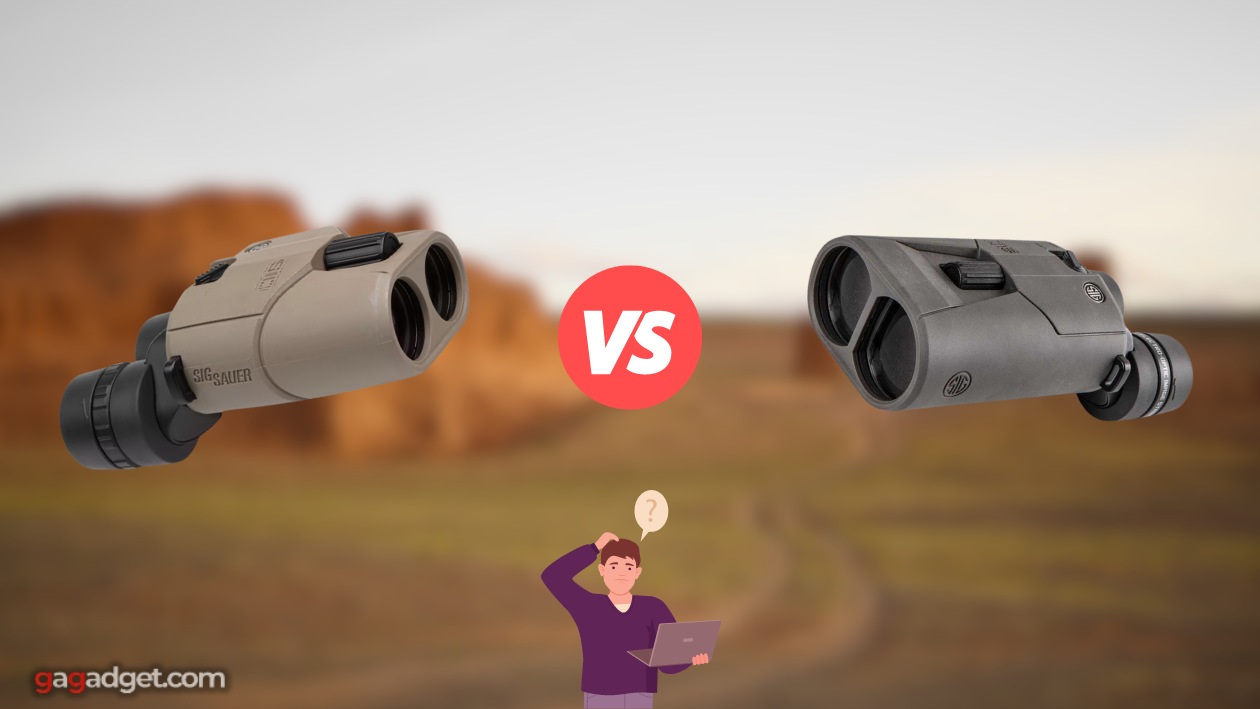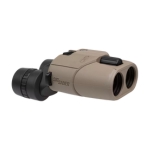SIG SAUER ZULU6 HDX 20x42 mm vs ZULU6 HDX 16x42 mm
Hey there, optics enthusiasts! Jim here, back with another head-to-head shootout between two cutting-edge binoculars. This time we're pitting the impressive SIG SAUER ZULU6 HDX 20x42mm against its slightly lower-powered sibling, the SIG SAUER ZULU6 HDX 16x42mm. Both of these high-end binos feature state-of-the-art image stabilization, HDX glass, and rugged construction that set a new standard for handheld glassing. But which one reigns supreme? Let's find out!
As an avid hunter and gear junkie, I've spent extensive time in the field with both ZULU6 HDX models, evaluating their optical clarity, low-light performance, ergonomics, and real-world usability. In this comprehensive comparison, I'll share my hands-on experience to help you decide which one best fits your needs and budget. Buckle up and let's dive in!

SIG SAUER ZULU6 HDX 20x42mm vs 16x42mm: Quick Roundup
In a hurry? Here's the bottom line: The SIG ZULU6 HDX 20x42mm and 16x42mm are both premium image stabilized binoculars ideal for long-range glassing. They share the same HDX glass, dual-barrel gimbal system, and armor coating. The 20x42 offers 25% more magnification and a touch longer eye relief, while the 16x42 has a wider FOV and weighs about 2 oz less. Optical quality and features are identical otherwise.
For most users, I recommend the SIG SAUER ZULU6 HDX 16x42mm. The 16x power is the sweet spot for handheld use, with ample reach and a wide, stable view. Coupled with best-in-class stabilization and virtually identical optics to the 20x42, it's a more versatile all-around performer. The 20x42 is killer for long-range surveillance and digiscoping but the narrower FOV and added bulk can be fatiguing for extended sessions.
Table of Contents
SIG ZULU6 HDX 20x42mm vs 16x42mm: Comparison
| Specification | SIG ZULU6 HDX 20x42mm | SIG ZULU6 HDX 16x42mm |
| Image |

|

|
| Magnification | 20x | 16x |
| Objective Lens Diameter | 42mm | 42mm |
| Prism System | Schmidt-Pechan | Schmidt-Pechan |
| Image Stabilizer | Yes (2-axis gimbal) | Yes (2-axis gimbal) |
| Eye Relief | 15mm | 14mm |
| Field of View | Not specified | 3.8° (linear FOV at 1000 yds) |
| Optical Coating | Spectracoat | Spectracoat |
| Close Focus | 8.2 m | 8.2 m |
| Interpupillary Distance | 56-75mm | 56-75mm |
| Diopter Adjustment Range | -3 to +3 dpt | -3 to +3 dpt |
| Waterproof Rating | IPX-4 | IPX-4 |
| Dimensions | 7.08" x 4.72" x 2.6" | 7.1" x 4.72" x 2.5" |
| Weight | 21.9 oz | 20 oz |
| Finish | Rubberized/FDE | Rubberized/FDE |
| Year | 2023 | 2023 |
On paper, the SIG SAUER ZULU6 HDX 20x42mm and 16x42mm are extremely closely matched, with identical coatings, prism system, focus range, eye relief, and overall build. Both employ SIG's cutting-edge HDX glass, lightweight magnesium chassis, and proprietary SpectraCoat multi-coating. The oversized 42mm objectives hoover up light for excellent brightness even at the high magnifications.
The main difference, of course, is in magnification. The 20x42 offers 25% more power than the 16x42 for greater long-distance reach and detail resolution. On the flip side, that extra boost costs you some field of view (expect around 25% narrower than the 16x), 2 additional ounces of weight, and slightly shorter battery life. Eye relief is also a hair tighter at 15mm vs 14mm but still very comfortable.
Both models feature the same impressive 2-axis gimbal stabilization system that virtually eliminates shake and judder at any power. It's truly a game changer for handheld viewing, allowing rock solid images even at 20x. The ZULU6's electronic wizardry is driven by a single CR123 battery with a very respectable 4-6 hour runtime depending on usage. USB-C recharging is quick and easy in the field.
Spec sheets are one thing, but real-world performance is what matters. Having put both models through their paces in various lighting and weather conditions, I can confidently say that the SIG ZULU6 HDX 20x42mm and 16x42mm deliver some of the finest images I've seen in this class.
The HDX glass and SpectraCoat really shine, serving up exceptionally bright, sharp, high-contrast views with excellent color fidelity and virtually zero distortion edge to edge. Both models resolved fine details like animal fur, bark patterns, and even text on signs at impressive distances. I could easily pick out bullet holes on steel at 200 yards and read trail markers at 400+. CA is extremely well controlled with no noticeable fringing even on high-contrast edges.
In terms of head to head, the 20x42 predictably pulls ahead at maximum magnification, revealing lettering, terrain features, and game details about 25% further out than the 16x42. It's an impressive feat of optical engineering that will be much appreciated by long-range shooters, guides, and LE/security personnel. The scope-like power does require a bit steadier hands and more precise panning to locate small subjects. But once locked on, the extra reach is addictive.
The 16x42, on the other hand, hits a real sweet spot for general use with greater FOV, speed, and handling. At 3.8 degrees, the linear field of view equates to about 198 feet at 1000 yards - pleasantly wide for scanning open country and acquiring moving targets. Wildlife observers and spotters will appreciate the ability to quickly find and follow animals on the hoof. I also found the lower power noticeably easier to hold steady for long durations when tripods were impractical.
Both models exhibited excellent light transmission and low-light performance thanks to the sizable 42mm objectives and quality glass. In a side by side comparison against my midrange 42mm at dusk, the ZULUs pulled ahead by a solid 10-15 minutes of usable glassing time. A nice boost for hunters and tactical users operating around dawn and dusk. The 16x42 does have a slight edge here due to the larger 2.6mm exit pupil but it's very close.
Optical stabilization is superb on both models, eliminating 90%+ of visible shake at any magnification. The effect is most dramatic at 20x where even heavy breathing and heart beat are erased, yielding a rock-solid sight picture. But it's also a huge boon at 16x, enabling comfortable extended viewing that would quickly become fatiguing with traditional binos. Several minutes of handheld stargazing was no problem. Panning is silky and precise on both, easily controlled with gentle hand movements. Hard to beat short of a tripod.
SIG ZULU6 HDX 16x42mm vs 20x42mm: Design
SIG ZULU6 HDX 20x42mm Design
SIG ZULU6 HDX 16x42mm Design
From a build quality and ergonomics standpoint, the SIG ZULU6 HDX 20x42mm and 16x42mm are virtually identical and wonderfully over-engineered. Both feature a robust yet lightweight magnesium chassis wrapped in thick, tacky rubber armor that just oozes quality. All touchpoints are thoughtfully textured for positive grip even with wet or gloved hands. You could probably hammer nails with these things although I wouldn't recommend it!
I really appreciated the ZULU6's streamlined dual-hinge design which provided a comfortable, fatigue-free grip during long sessions. Balance is excellent for the weight with most of the heft close in to the eyepieces for maximum stability. The open bridge also leaves plenty of room for a tripod adapter without obstructing the focus wheels. Considering all the electronics packed inside, these are remarkably svelte units, with the 16x42 being slightly more compact overall.
Tactile controls are perfectly placed and differentiated for no-look operation. The large rubberized focus wheel turns with buttery smooth resistance while the diopter is conveniently located at the front of the bridge. Mode and stabilization buttons are distinct and positioned for easy access with your thumbs. The twist-up eyecups are particularly nice with firm detents and just the right amount of resistance.
Other welcome details include tetherable lens caps, a nice padded neck strap, and a semi-rigid zipper case that actually protects the optics. The included lens cloth is one of the thickest and softest I've used - no annoying lint or streaking. Documentation is refreshingly clear and well illustrated. It's this attention to the little things that separates good binos from great ones.
Any complaints? Not really. The eyecup diameter is a hair small for my taste but your mileage may vary. I also wouldn't have minded seeing a bit more waterproofing but the IPX4 rating should be plenty for most conditions short of submersion. This is really nitpicking - overall fit, finish, and functionality are top notch on par with European optics costing 2-3X as much. SIG knows how to build tank-like yet ergonomic binos.
SIG SAUER ZULU6 HDX 20x42mm vs 16x42mm: User Reviews
But don't just take my word for it. Here's what other buyers have to say about their ZULU6 HDX 20x42mm and 16x42mm binoculars:
SIG SAUER ZULU6 HDX 20x42mm User Reviews:
Praises: "Insane detail at long ranges. I can count antler tines and judge game way further out than with my old 10x42s. Image is razor sharp with zero shake."
"Built like a tank but still comfortable for long glassing sessions. The aggressive armor really locks into your hands. Focusing is super precise."
***
Drawbacks: "Not much, honestly. I guess the FOV is a bit narrow for scanning but that's physics. A tad heavy for backpacking but fine for my uses."
"Definitely overkill for casual nature viewing but pure joy if you need max reach and detail. The magic comes at a price but IMO it's worth it."
SIG SAUER ZULU6 HDX 16x42mm User Reviews:
Praises: "16x is the perfect balance of power and FOV for me. Substantial upgrade over my old 12x50s in clarity and brightness. Stabilization is scary good."
"Unreal low light performance for 42mm objectives. I can easily pick out game 30+ mins after sunset. Stabilization is a revelation for shaky hands like mine."
***
Drawbacks: "Minor but I wish the eyecups had one more intermediate position for my eye relief. The diopter is also a bit tight to adjust. But overall extremely satisfied."
"Not a cheap date but you get what you pay for. The glass, coatings, stabilization, and build are all top shelf. Buy once cry once."
Common threads? Users rave about the ZULU6's cutting-edge clarity, rock-solid stabilization, premium build, and comfortable handling. Many appreciate the 16x42's ideal balance of magnification and field of view for general use. While the 20x42's unreal reach makes it a favorite for long-range shooters and guides. Objectively these are both heirloom-quality optics with performance that justifies the premium price for serious users.
Negative feedback is limited and mostly focused on minor ergonomic nitpicks rather than quality concerns. The odd mention of price and weight is more than offset by praise for the advanced features and bombproof construction. It's a testament to SIG's obsessive engineering and QC that there are virtually no complaints about reliability, water entry, or defects. These are binos you can depend on for a lifetime of hard use in harsh conditions.
SIG SAUER ZULU6 HDX 20x42mm & 16x42mm Alternatives
Of course the ZULU6 HDX series isn't the only game in town for premium portable glassing. Here are a couple other high-end options worth considering:
- Zeiss Victory RF 10x54: Often considered the gold standard for rangefinding binos, the Victory RF offers legendary Zeiss optics, 2500 yard ranging, real-time ballistic calculation, and best-in-class coatings in an extremely rugged (albeit heavy) package. If you want maximum visual and ranging horsepower and don't mind the 40 oz carry weight, this is the king;
- Leica Geovid 3200.COM 10x42: Another top-tier electro-optic marvel, the Geovid combines world class German glass with onboard ballistic computing, BlueTooth, and an integrated real-time wind meter. It's like having a Kestrel built directly into your binos. Very pricey but unmatched integration of observation, ranging, and ballistic tools.
The Zeiss Victory RF 10x54 is widely regarded as the pinnacle of optical quality and technology. Its Abbe-Koenig prisms, FluorideHD/HT glass, and T* coatings deliver unrivaled clarity, color fidelity, and low light performance that rivals many smaller spotting scopes. The integrated laser rangefinder is exceptionally accurate to 2500 yards and the BIS ballistic solver makes holdover corrections a snap. All in a nearly indestructible yet ergonomic magnesium housing. Downsides? It's extremely heavy at 40 oz, bulky for backpacking, and breathtakingly expensive at $3500+. But if you demand nothing less than the best for long-range adventure and aren't weight or budget constrained, this is grail material.
In the opposite corner, the Leica Geovid 3200.COM 10x42 goes all in on optical tech integration. Onboard you get a cutting-edge laser/microprocessor rangefinder, digital compass, BlueTooth, internal atmospheric sensors, and real-time wind detection - all tied together with a full-featured ballistic computer. Glass and coatings are unsurprisingly world class for superb clarity and light transmission. It's like having a long-range hunting/shooting PDA built into your binos.
Should You Buy the SIG ZULU6 HDX 20x42mm or 16x42mm?
When all's said and done, the SIG SAUER ZULU6 HDX 20x42mm vs 16x42mm represent two of the most advanced handheld optics available at any price range. With their cutting-edge HDX glass, dual-gimbal stabilization, and battlefield-worthy construction, these are binoculars designed for absolute maximum long-range performance in the harshest environments. Choosing between them largely comes down to personal magnification preference and size/weight priorities.
For the majority of users, I strongly recommend the SIG SAUER ZULU6 HDX 16x42mm. The 16x magnification is a great balance of reach and usability, providing enough power to resolve distant details without overly compromising field of view or handhold-ability. Paired with the same stellar optics, mega-bright 42mm objectives, Spectracoat, and unreal OIS as the 20x42, it's an incredibly versatile spotter for everything from hunting to birding to scouting. All in an ergonomic package you can comfortably tote anywhere.
On the other hand, if you demand the absolute maximum handheld magnification available, the SIG SAUER ZULU6 HDX 20x42mm is a compelling option. The extra 25% boost in power is a serious asset for long-range tactical observation, enabling reliable ID of people and game at truly impressive distances. LE, military, and professional guides will appreciate the ability to generate a rock-solid "spotting scope in your pocket" on any terrain. Just be prepared for a narrower FOV and a couple extra ounces over the 16x42 - reasonable trade-offs for the extended eyes.
Regardless of which model you choose, you can buy with confidence knowing you're getting one of the toughest, smartest, most capable set of binos money can buy. The combination of premium HDX glass, advanced prism/coating tech, and uncanny stabilization puts the ZULU6 HDX in rarified air for discerning users. Once you experience the SIG difference in optical quality and reliability in the field, you'll never want to go back to lesser optics.
I hope this detailed comparison has helped you determine which SIG SAUER ZULU6 HDX binocular is ideal for your needs and budget. Both are phenomenal performers that exemplify the state of the art in handheld spotting. Let me know if you have any other questions and I'll be happy to advise. In the meantime, get out there and experience the world in unshakable HD clarity!
Other Optics Articles You Might Like:






